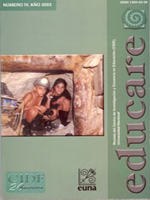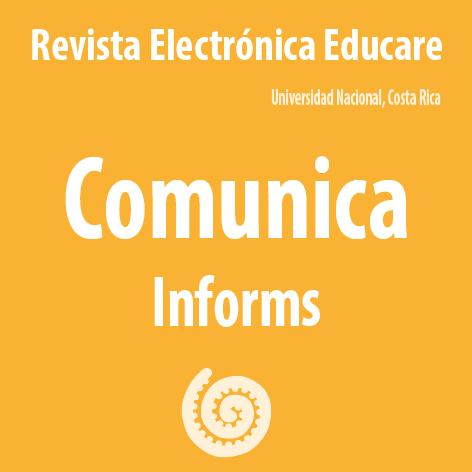Favorecer la colaboración por medio de las Tic: el nuevo desafío de la formación práctica de los futuros profesores y profesoras
DOI:
https://doi.org/10.15359/ree.2003-4.11Resumo
El presente estudio contribuye a la comprensión de las ventajas del uso de Tecnologías de Información y Comunicación (TIC) en la formación práctica de maestros de secundaria, en el contexto de un programa de formación de la Universidad de Quebec en Hull (Canadá). Mediante una metodología de análisis cualitativo, se analizan los mensajes de dos grupos de participantes inmersos en un entorno de aprendizaje colaborativo con integración de TIC (sitio Web multimedia-foro electrónico de discusión). El análisis del contenido de la muestra de mensajes, resultante de las interacciones de los participantes, destaca el intercambio de experiencia de aprendizaje en situaciones de la práctica escolar diaria, por ejemplo: compartir experiencias personales, retroalimentación, consejos pedagógicos, estímulos y solidaridad, principalmente, pero también el nulo cuestionamiento de sus posiciones. Las numerosas colaboraciones atestiguan que los intercambios y las experiencias compartidas, constituyen una comunidad de aprendizaje, en la que los maestros se sienten revalorizados y con mayor confianza para el desarrollo de su competencia.
Referências
Alavi, M. (1994). Cornputer-rnediated collaborative leaming: An ernpirical evaluation. MIS Quarterly, 18(2), 159-174.
Barker, B. (1986). Efforts to lmprove the Preparation ofTeachers for Rural Schools. ERIC Publications (ED265993).
Berge, Z. L. ( 1995). Facilitating cornputer Conferencing: Recornrnendations Frorn the Field. Educational Technology. 35 (1), 22-30.
Berge, Z.L. ( 1995). Facilitating Cornputer Conferencing: Recornrnendations Frorn the Field. Educational Technology. 35 (1) 22-30.
Bourbeau, L. ( 1997). La formation pratique a I' enseignernent: l' organisation des stages en rnilieu scolaire: rapport d'enquete. Québec: FECS.
Bruner, J. ( 1990). Acts of M eaning. Boston, MA: Harvard U niversity Press.
Cecez-Kecrnanovic, D. & Webb, C. (1999). Towards a Communicative
Model ofCollaborative Web-mediated Leaming. ASCILITE 1999: Responding to Diversity, Brisbane (Australie), 5-8 décernbre.
Cecez-Kecrnanovic, D. and Webb, C. (2000) A critica! inquiry into webrnediated collaborative learning. In Aggarwal, A.K. (ed.) Web-based Learning: Opportunities and Challenges. Hershey, PA: the IDEA Group Publishing. p. 132-141.
Hiltz, S.R. (1995) The Virtual Classroorn: Leaming Without Lirnits vía
Cornputer Networks, New Jersey: Ablex Publishing Corp.
Huberrnan, A.M., & Miles, M.B. (1991). Analyse des données qualitatives. Recueil de nouvelles méthodes. Bruxelles: De Boeck Université.
Huberman, A.M., & Miles, M.B. (1994). Data Managernent and Analysis
Methods. In N.K. Denzin & Y.S. Lincoln (Eds.), Handbook of Qualitative
Research. Thousand Oaks, CA: Sage Publication.
Huynh, M.Q. ( 1999) A Critical Study of Computer-Supported Collaborative Learning. PhD, Binghamton, New York: SUNY.
Johanson, R. P.: Norland, D. L.; Olson, E.: Huth. L.: Bodensteiner, R. ( 1999). Internet and List-Serves To Support the Student Teaching Sernester. ERIC publications (ED428060)
Johnson, D. W. & Johnson R. T. ( 1996). Cooperation and the use of
technology. In Handbook of Research for Educational Communication and Technology, ed. D. Jonassen. Macrnillam, New York: Macmillan. p. 1017-1044.
Johnson, D. W. & Johnson R. T. ( 1998). Cooperative Learning and Social Interdependence Theory. [document disponible en ligne]: http://www.clcrc.com/pages/SIT.html. [30 juin, 2001].
Johnson, D. W., Maruyama, G., Johnson, R. T., Nelson, D., and Skon, L.
(1981) 'Effect of cooperative, competitive, and individualistic goal structures on achievement: A meta analysis'. Psychological Bulletin, 89, 47-61.
Karsenti, T. ( 1999). Comment le recours aux TIC en pédagogie universitaire peut favoriser la motivation des étudiants: le cas d'un cours médiatisé sur le Web. Cahiers de la recherche en éducation, 6 (3) : 455-484.
Karsenti, T. et Larose, F. (2001). Les TIC ... au cceur des pédagogies
universitaires. Québec : Presses de l'Université du Québec.
Kecmanovic et Webb, 1999.
L'Écuyer, R. ( 1990). Méthodologie del' analyse développementale de contenu.
Méthode GPS et concept de soi. Sillery, Qc: Presses de l'Université du Québec.
Marttunen, M. ( 1998). Electronic mail as forum for argumentative
interaction in higher education studies. Journal of Educational Computing
Research. 18(4), p. 387-405.
Ministere de l'Éducation du Québec (2001a). La formation a
l'enseignement: Les orientations, Les compétences professionnelles. Québec Gouvernement du Québec.
Ministere de l'Éducation du Québec (2001b) Programme deformation de l'école québécoise. Éducation préscolaire et enseignement primaire, Québec: Gouvernement du Québec.
Moore, M.G. (1993). Toree types of interactions. In K. Harry & M. Johns (Éds.). Distance education: New perspectives. Londres: Routledge. P. 19-24.
Mory, E. H. (1992). Use of infonnation feedback in instruction implications for future research, Education Technology Research and Development, 40 (2), 40-43.
Nault, G. (2000). Exploration d'un dispositif de supervision des stagiaires via Internet. Mémoire de maí'trise. Montréal: Université du Québec a Montréal.
Nault, T. et Nault, G. (2001). Quand les stages attrapent les TIC. In Karsenti, T. et Larose, F., Les TIC ... au creur des pédagogies universitaires. Québec: Presses de l'Université du Québec.
Newman, D.R., Johnson, C., Webbs, B. & Cochrane, C. (1997). Evaluating the quality of learning in computer supported co-operative learning. Joumal of
the American Society for lnfonnation Science. 48(6), 484-495.
Nipper, S. (1989). Third generation distance learning and computer
conferencing. In R. Mason & A. Kaye (Éds).). Mindweae: Communication, computers and distance education. Oxford (UK) : Pergarnon. pp. 63-73.
O'Neill, A. (1996). Increasing reflective instructional decision-making by clinically supervising teachers using telecommunications. Proceedings of theAnnual National Educational Computing Conference (Mineapolis, Minesota, 11-13 juin).
Piaget, J. (1962). Le langage et la pensée chez l'enfant. Paris: Presses
universitaires de France.
Pugach, H & Johnson, L.J. (1995) Collaborative practitioners and
collaborative schools. Denver: Love Publishing Company.
Savoie-Zajc, L. (2000). La recherche qualitative. In Karsenti, T. et SavoieZajc, L., Introduction a la recherche en éducation. Sherbrooke: Éditions du CRP.
Schlagal, B., Trathen, W. et Blanton, W. (1996). Structuring telecommunications to create instructional conversations about student teaching. Journal of Teacher Education, 47 (3), p. 175-183.
Searle, J.R. (1979). Expression and Meaning, Cambridge: Cambridge
University Press.
Sedlack, R.G., & Stanley, J. (1992). Social Research: Theory andMethods. Boston, MA: Allyn and Bacon.
Slavin, R.E. (1987). Cooperative Leaming: Student Teams, Washington:
National Educational Association.
Sringam, C. & Geer, R. (2000). An Investigation of an Instrument for
Analysis of Student-Led Electronic Discussions. ASCILIT E 2000: Leaming to choose, choosing to learn, Coffs Harbour (Australie), 9-14 décembre.
Stacey, E. (1998). Study of the enhancement of learning through group
interaction by computer mediated communication. These de doctorat. Monash University, Melbourne, Australie.
Tuovinen, J.E. (2000). Multimedia distance education interactions.
Educational Media International, 37 (1), 16-24.
Venn, M. L.; Moore, R. L.; Gunter, P. L. (2001). Using AudioNideo
Conferencing To Observe Field-Based Practices of Rural Teachers. Rural Educator; 22(2), p. 24-27.
Vygotsky, L.S. (1978) Mind in Society: The Development of Higher
Psychological Processes, Cambridge, MA: Harvard University Press.
Winiecki, D. (1999). Studying and Analysing Asynchronous Conversations in Distance Education. Communication présentée lors du First International Interdisciplinary ConferenceAdvances in Qualitative Methods (Edmonton, 1-2 mars).
Yaverbaum, G. J.; Ocker, R. J. (1998). Problem Solving in the Virtual
Classroom: A Study of Student Perceptions Related to Collaborative Leaming Techniques. ERIC publications (ED427750).
Zeichner, K. (1992). Rethinking the Practicum in the Professional Development School Partnership. Joumal ofTeacher Education; 43(4), p. 296-307.
Publicado
Como Citar
Edição
Seção
Licença
- Caso o artigo seja aceito para publicação, os autores permitem a cessão GRATUITA, EXCLUSIVA E INDEFINITA de seus direitos patrimoniais à Universidade Nacional (UNA, Costa Rica). Para obter mais detalhes, consultar a Carta de originalidade e cessão de direitos.
- Direitos de reutilização: a UNA concede aos AUTORS(AS) o direito de reutilizar para qualquer propósito, incluindo o auto arquivo, e a publicação na Internet ou em qualquer website da versão final aprovada e publicada (post print) do artigo, desde que seja feita para fins não lucrativos, não gere trabalho derivado sem autorização prévia e respeite as fontes de autoria.
- A oferta e possível publicação do artigo na Revista Electrónica Educare reger-se-á pelas suas políticas editoriais, pela regulamentação institucional da Universidade Nacional e pela legislação da República da Costa Rica. Além disso, quaisquer divergências futuras de opinião ou disputa serão resolvidas de acordo com os mecanismos de Resolução Alternativa de conflitos e a Jurisdição da Costa Rica.
- Em todos os casos, entende-se que as opiniões emitidas são de responsabilidade dos autores e não refletem necessariamente a posição e a opinião da Educare, CIDE ou da Universidade Nacional, Costa Rica. Entende-se também que, no exercício da liberdade acadêmica, os autores realizaram um rigoroso processo científico-acadêmico de pesquisa, reflexão e argumentação e que se enquadra na área temática de interesse da Revista.
- Os artigos publicados pela Revista Eletrônica Educare utilizam a Licença Creative Commons:















 The articles published by Educare Electronic Journal can be shared with a Licença Creative Commons :
The articles published by Educare Electronic Journal can be shared with a Licença Creative Commons : 



